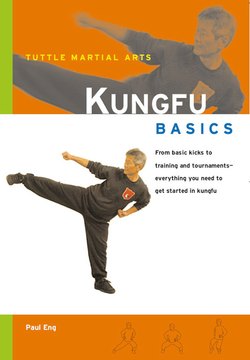Читать книгу Kungfu Basics - Paul Eng - Страница 14
На сайте Литреса книга снята с продажи.
ОглавлениеTHE CLOTHES AND EQUIPMENT you will need very much depend on the school. Some schools like their students to wear a common uniform, and, in such cases, the school will usually sell what is required. Other schools allow students to dress as they like, although they often have guidelines. The following gives a general idea of what to expect.
Respect
The first principle to remember is that what you wear expresses your attitude and should show respect to the sifu, the school, and the art. Specifically this means:
1 Make sure whatever you wear is clean and neat, without holes, and is appropriate for a serious workout.
2 Do not wear a uniform from another martial art (such as karate).
3 Do not wear a uniform with a logo or emblem from another kungfu school.
The Basic Uniform
Colors
The traditional color for kungfu clothes is black—shirts, sashes, pants, and shoes. There are exceptions. In some schools, instructors may wear white to distinguish themselves from the students and make it easy for students to spot them to ask them questions. In sparring opponents may wear different-colored shirts. Schools of some styles are adopting different colored sashes to indicate rank, as in karate. For demonstrations colorful uniforms (especially in silk) are appropriate, especially for wushu, but black is generally the standard color for kungfu clothes and footwear.
Shoes
You must wear shoes; kungfu is not done in bare feet. (This is consistent with its origins as a form of self-defense in daily life.) Shoes should be sturdy, lightweight, and flexible. They must allow free ankle movement, which is required for toe and heel kicks and some of the deep stances. The soles should provide cushioning for stomping, should provide some traction—that is, they should not be slippery—but should not have deep treads that could interfere with executing smooth floor sweeps. They should not have metal buckles that might cause injury in kicking. Many people find that skateboard shoes are ideal. Beware of shoes made in China. While they appear more traditional and can be cheap, they may not be very functional. They have no arch, and some have thin, hard rubber soles that can be quite uncomfortable, if not painful. (If you like the style, wearing heavy socks may provide enough cushioning for comfort.)
Pants
Traditional kungfu pants are made of cotton. They typically have elastic cuffs at the bottoms of the legs and elastic as well as a drawstring at the waist. They are cut loose, if not baggy, often with an extra triangular piece of fabric sewn into the crotch to ensure freedom of movement for high kicks and jumps. When wearing a sash, students may wear one-size-larger pants so that the elastic band can be positioned above the sash, while the legs will still be long enough to “blouse” slightly at the ankles.
Sashes
Sashes are generally not worn by beginners; however, they may be commonly worn by senior students and instructors. Sashes are typically made of silk, six to nine inches wide and nine to fourteen feet long. The proper length of the sash is determined by the person’s waist: twice the waist measurement is the minimum, while four times the waist measurement is considered more desirable and more comfortable. Black is the traditional color, but other colors are being adopted by some schools as an indication of rank, much like the karate system. Originally, the sash worn in China served other purposes, in addition to simply holding up the pants. First, it was worn to support the lower back and control the breathing center (the dan tian). Second, very practically, it was used to conceal small weapons. The sash also served as a symbol of one’s country and ancestors, and the way it was tied indicated rank. Masters of literature and calligraphy wore their sashes tied on the left; masters of martial arts, in the middle; while martial arts students wore theirs tied on the right.
The proper way to tie the sash is a traditional technique that the instructor will demonstrate when needed.
Shirts/Jackets
In most schools cotton T-shirts are worn in the summer and sweatshirts in the winter. In some schools—especially large schools—the instructors and assistant instructors (senior students) may wear white shirts. This makes them conspicuous, so beginning students can easily distinguish instructors from students to ask them questions. Also, sometimes for two-person forms, one participant will wear a white shirt and the other a black shirt to distinguish the two sides of the form.
Extra Equipment
For Protection
For free-sparring protective equipment such as headgear, gloves, groin protection, and mouth protection should be worn by both men and women. Beginners will not need this equipment because free sparring usually begins only at the intermediate level after students have learned two-person forms and pre-arranged sparring.
For Competitions and Performances
For competitions, tournaments, and public performances, the school may ask students who will be participating to dress uniformly (for example, T-shirt with the school logo and black pants or a special costume). For these occasions participants will usually be told well in advance what they need to buy and how/where to buy it.
